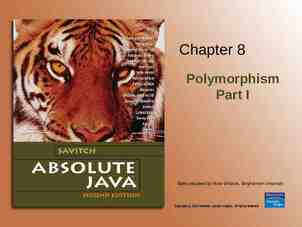March 2020 doc.: IEEE 802.11-20/0005r1 Proposals on Latency
13 Slides103.39 KB
March 2020 doc.: IEEE 802.11-20/0005r1 Proposals on Latency Reduction Date: 2020-03-16 Authors: Name Affiliations Shubhodeep Adhikari Sindhu Verma Matthew Fischer Vinko Erceg Address Phone Email [email protected] Broadcom [email protected] [email protected] [email protected]
March 2020 doc.: IEEE 802.11-20/0005r1 High priority proposals 1. In a TXOP acquired by a non-AP STA and shared with an AP, allow the AP to transmit low latency control/data to any STA. 2. Fast switching of the primary channel. 3. Flexibility to transmit on any idle subset of a given set of channels on which CCA is attempted. 4. TDM multilink instead of concurrent multilink. Lower priority proposals 5. Semi-persistent allocations for low latency data; the allocations being optionally shared across BSSs. 6. Unsolicited transmission of Scheduling Request Indication on arrival of data; optionally on semipersistently allocated resources. 7. Preemption of ongoing lower priority transmission. 8. EDCA prioritization of low latency data either using the Alternate VO queue or by defining a new Access Category.
March 2020 doc.: IEEE 802.11-20/0005r1 Proposal 1: In a TXOP acquired by a non-AP STA and shared with an AP, allow the AP to transmit low latency control/data to any STA. In 802.11, in normal operation, only an AP can share its TXOP with its clients. Such sharing increases transmission efficiency by reducing channel access attempts at the clients to transmit UL data. The Reverse Direction (RD) protocol allows TXOP sharing between an RD Initiator and Responder, where the Initiator can be a non-AP STA. However, the protocol allows only a limited version of such TXOP sharing. For example, the RD Responder (say an AP) can transmit data only to the RD Initiator (say a non-AP STA) and inclusion of traffic to other STAs can only be done in an MU-MIMO fashion and without extending the duration of transmission to the RD Initator. We propose the following: In a TXOP acquired and shared by a non-AP STA, AP can transmit low latency control/data or even other data to any STAs. Optionally: TXOPs can be shared between nodes in different BSSs via inter-BSS coordination. Can include gaps between consecutive transmissions, with PIFS CCA preceding such transmissions. Standardization Effort: Low
March 2020 doc.: IEEE 802.11-20/0005r1 Continued: Productization effort: Moderate Regulatory changes: The ETSI-BRAN harmonized standard for 5 GHz (EN 301.893) allows the following: An Initiating Device to share its TXOP with a Responding Device, where the Responding can use the shared TXOP to transmit data to any node. The Initiating Device can be a non-AP STA and the Responding Device can be an AP. Gaps between such transmissions. For gaps 16us a 25us, a fixed duration ED-only CCA is necessary before transmission. Updates in the harmonized standard may be needed if inter-BSS TXOP sharing is required. LAA/NR-U benchmark: Specified by LAA/NR-U, to the extent allowed by the ETSI harmonized standard.
March 2020 doc.: IEEE 802.11-20/0005r1 Proposal 2: Fast switching of the Primary channel Multi-channel transmissions in 802.11 require the primary channel to be available. This means that transmission on all channels are blocked (even if they are idle) whenever the primary channel is not available. An option to reduce this problem is to enable fast switching of the primary channel. Even though 802.11 provides for channel switching, the switching frequency is limited by the TWT durations on the primary channel. Reducing the TWT durations would increase power usage for non-AP STAs and beacon overhead. We propose the following: Enable fast primary channel switching while maintaining optimal TWT durations, by making the AP switch the primary channel but continue transmitting beacons with the Channel Switch message on the older primary channel until the TWT periods of all non-AP STAs are over. Primary channel switching can be based on load/SINR/error statistics of the primary and secondary channels. Standardization effort: Low Productization effort: Low
March 2020 doc.: IEEE 802.11-20/0005r1 Continued: Regulatory changes: In configurations that use a use Full CCA (random truncated exponential backoff) on the primary and PIFS CCA on the remaining channels, the ETSI harmonized standard for 5 GHz allows switching the primary channel either in (1) a uniform random manner; or (2) in an arbitrary manner but not more than once every second. So, changes in ETSI are required if the primary channel switches in a non-random manner more frequently than once every second. LAA/NRU benchmark: In addition to the channel bonded Full CCA on primary PIFS CAA on secondary scheme as in 802.11, LAA/NRU specify multicarrier schemes where there is no dependence on a single channel being idle. Even in the Full CCA PIFS CCA based scheme, there is no role of the primary channel other than being the channel on which Full CCA is performed; so this primary channel can be switched as fast as the regulations permit.
March 2020 doc.: IEEE 802.11-20/0005r1 Proposal 3: Flexibility to transmit on any free subset of a given set of channels on which CCA is attempted Another method to avoid the blocked primary channel problem is to be able to transmit on any free subset of a set of channels on which a device attempts CCA. It is possible in-principle to transmit on the free secondary channels even if the primary channel is not available. However, since 802.11 performs Full CCA only on the primary channel and PIFS CCA on the secondary channels, such “secondary channel only” transmission would not be allowed by regulations. Doing so would also lead to poor coexistence with legacy 802.11 devices. We propose the following: Allow transmissions on any free subset of channels on which a STA attempts CCA by performing Full CCA (based on random truncated exponential backoff) on all the channels. Standardization effort: Low Productization effort: Low, if an ED-only CCA scheme is used on all channels. More effort is required for an ED PD scheme. Regulatory changes: The ETSI harmonized standard for 5 GHz allows transmission on any free subset of channels as long as Full CCA is performed on each such channel. LAA/NR-U benchmark: Allow such transmissions.
March 2020 doc.: IEEE 802.11-20/0005r1 Proposal 4: TDM multilink instead of concurrent multilink. Transmission is limited to a single link at a time, with multiple links being used for transmissions in a TDM manner within the multilink framework. Can lower complexity or conserve power and still get better performance relative to a single link setup. Expected performance gain is similar to selection diversity schemes. We propose the following: The AP can share its TXOP with the no-AP STA on all or some of the TDM links. The AP can indicate via transmissions on the current operating links the parameters necessary for TXOP sharing/switching on other links. TXOP sharing can optionally have a gap between consecutive transmissions. The link switching can be initiated by the AP based on measurements performed by AP or/and reported by the non-AP STA. The link switching can be initiated by the non-AP STA and may/may not involve a handshake message with the AP. Standardization effort: Low, since most of the effort will be rolled up as part of multilink standardization. Productization effort: Low, since of the effort will be rolled up as part of multilink implementation. Regulatory changes: None. Already allowed by the ETSI harmonized standard for 5 GHz. LAA/NR-U benchmark: Not present in LAA/NR-U.
March 2020 doc.: IEEE 802.11-20/0005r1 Lower priority proposals
March 2020 doc.: IEEE 802.11-20/0005r1 Proposal 5: Semi persistent allocation of narrow bandwidth resources at the band edges of a BSS We propose the following: Expedited transmission of low latency data by semi-persistently allocating narrow bandwidth resources. These resources can be allocated within the TXOP of an AP or a non-AP STA and can be used to transmit low latency data. Will occupy narrow bandwidths, if possible at the two edges of the occupied bandwidth of the BSS, in order to increase diversity. Support time and frequency multiplexing of low latency data to/from multiple STAs. The multiplexing can be made via orthogonal or quasi orthogonal codes. Can be shared across BSSs via inter-BSS coordination. This can also reduce contention/collision for transmission within such resources.
March 2020 doc.: IEEE 802.11-20/0005r1 Proposal 6. Unsolicited transmission of Scheduling Request indicator for faster notification and transmission of UL and DL data At present, the BSR Control subfield contains buffer status information for triggered UL operation. The BSR is triggered by a BSRP. UL latency can be improved if the STA can use semi-persistently allocated control resources to transmit an indication to the AP notifying that it has data to transmit in the UL, which may then make the AP send a BSRP. We propose the following: Unsolicited transmission of a compressed Scheduling Request indicator for a non-AP STA to notify its AP that it has UL data for transmission. This indicator can use the semi-persistent resources as defined in Proposal 5. Some versions of the Scheduling Request indicator can also indicate additional information about the UL data, such as the priority and/or latency budget of the UL data. This information can be used by the AP to prioritize resource allocation to such an STA. The scheduling request indicator format can be similar NDP/NDP Report. Note: If a non-AP STA is allowed to share its TXOP with its AP, the AP too can send the Scheduling Request indicator to request an STA to relinquish its TXOP in favor of the AP. This can be used by the AP to transmit low latency data (control information to all STAs and data to at least the STA that won the TXOP as in Proposal 1).
March 2020 doc.: IEEE 802.11-20/0005r1 Proposal 7: Provision to preempt an ongoing transmission on arrival of low latency data We propose the following: Provision to preempt an ongoing transmission, such as on arrival of low latency data at either the AP or a non-AP STA. This would cause the transmitter to pause its ongoing transmission and to either start transmitting or enable transmission at some other node of the low latency data. The preemption indicator can be used for this purpose as follows: When received by the intended recipient of the low latency transmission, it prompts the recipient to start receiving or looking for the transmission for itself. When received by the current recipient of the ongoing transmission that has to be preempted, it prompts the recipient to treat its ongoing transmission appropriately by either discarding the segment received till now or saving it for any possible later (HARQ) combining. The preemption indication involves the following: A mechanism to indicate the presence of continued transmission or preemption of traffic by the transmitter such as by using a signal/bit. This indication can be transmitted in either or both of the following ways: In the narrow control region as defined in Proposals 1. Embedded within a normal data transmission, similar to a midamble. Further, the preemption indication can also be used for any node (even the node that is presently receiving an ongoing transmission) to request for preemption and request bandwidth on arrival of low latency data
March 2020 doc.: IEEE 802.11-20/0005r1 Proposal 8: Additional prioritization for low latency data We propose the following: Introduce additional prioritization for low latency data by the following: Use the Alternate Voice (A VO) queue for low latency data (reference: Figure 10-25 in IEEE 802.11-2016). Define a new Access Category with higher priority than AC VO for transmission of low latency data. Introduce strict upper bounds, duty cycle and TXOP limits to restrict transmissions that use the new Access Category in order to maintain fairness with other data. Introduction of such a higher priority access category can lead to increase in contention/collision, since such a priority class will use smaller values of backoff. So, this should in conjunction with coordination among nodes of the same or different BSSs (via inter-BSS coordination). Note: Suggestions on defining a new access category have also been discussed in IEEE 802.1119/1780r0


















